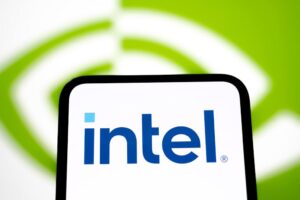The GPU maker’s stock continues to defy the odds, but has the company’s growth already peaked?
The adoption of artificial intelligence (AI) is continuing at a brisk pace, but some are waiting for the other shoe to drop. A strengthening U.S. economy and robust quarterly results from several AI-related companies helped push the Nasdaq Composite to a new record high last week. Yet these same factors have some investors wondering if the bull market has gone too far, too fast.
Nvidia (NVDA 1.99%) has become the de facto standard bearer for the generative AI industry. The company is scheduled to report its fiscal 2025 third-quarter results in less than three weeks, and it’s not an exaggeration to suggest that Wall Street is on pins and needles waiting for the clues that report will offer about the state of AI adoption. Nvidia’s sales have surged since the start of last year, driving the stock up 833% (as of this writing). It’s also less than 5% off the all-time high it touched late last month.
There’s a lot riding on Nvidia’s upcoming financial report, and many shareholders are wondering whether the stock can possibly continue its breathtaking run. Is it worth picking up shares ahead of its financial report on Nov. 20? Fortunately for investors, data has begun to pile up that could help answer that question.

Image source: Getty Images.
Sunshine on a cloudy day
The key to Nvidia’s astounding successes of the past couple of years has been the performance of its graphics processing units (GPUs), which are the best chips for supplying the specific type of computational horsepower necessary for generative AI, as well as other types of cloud computing needs. The necessary resources and the sheer magnitude of data involved limit the top-tier AI models to the world’s largest technology companies and cloud providers — most of which are Nvidia customers. Comments made in conjunction with those tech giants’ recent quarterly results provide some insights about the state of the AI revolution — and the evidence is clear.
For example, Microsoft (MSFT 0.99%) said it spent heavily to advance its AI agenda in its fiscal 2025 first quarter (which ended Sept. 30). The company had capital expenditures (capex) of $20 billion, which primarily went to support “cloud and AI-related” demand. CFO Amy Hood expects Microsoft’s spending spree to continue: “We expect capital expenditures to increase on a sequential basis given our cloud and AI demand signals,” she said.
During Alphabet‘s (GOOGL 0.10%) (GOOG -0.02%) third-quarter earnings call, CEO Sundar Pichai said, “Realizing [the opportunity] of AI requires … meaningful capital investment.” The company revealed capex of $13 billion during the quarter and suggested there would be “substantial increases in capital investment … going into 2025.”
Rounding out the big three cloud providers is Amazon (AMZN 6.19%). During its Q3 earnings call, CEO Andy Jassy called generative a “maybe once-in-a-lifetime type of opportunity … we’re aggressively pursuing it.” CFO Brian Olsavsky put that in context, saying Amazon’s capex would amount to roughly $75 billion this year, with much of that going toward cloud computing and AI infrastructure. The company also said it would unveil “100 new cloud infrastructure and AI capabilities” at AWS re:Invent later this month.
Finally, there’s Meta Platforms (META -0.07%). While it isn’t a cloud provider, the company’s social media sites attract 3.29 billion people every day, giving Meta vast volumes of user data. The company increased its full-year capex outlook to roughly $39 billion, and CFO Susan Li said, “We continue to expect significant capital expenditures growth in 2025.” She previously noted this was “to support our AI research and product development efforts.”
Why it matters
The trend of accelerating capex to support the growing demand for AI is clear. Additionally, a large fraction of that money will be spent on the data centers and servers needed for cloud computing — where the majority of generative AI software lives. As such, Nvidia will likely be the recipient of a good deal of this spending.
Nvidia has historically kept mum about its biggest customers, but that hasn’t stopped Wall Street from doing some digging. Analysts with Bloomberg and Barclays Research have run the numbers and come to the conclusion that Nvidia’s four biggest customers — generating a total of 40% of its sales — are:
- Microsoft: 15%
- Meta Platforms: 13%
- Amazon: 6.2%
- Alphabet: 5.8%
Each of these companies has left no question about their plans to spend heavily on capital expenditures, and in particular to spend heavily on infrastructure to support their cloud computing and AI aspirations. As the leading provider of data center GPUs, Nvidia will likely continue to top the list of beneficiaries of that spending.
Mark your calendar
Nvidia will deliver its next set of quarterly results on Nov. 20. After achieving triple-digit-percentage year-over-year growth for five consecutive quarters, the company has tried to rein in the market’s expectations, suggesting that its revenue growth this time will only clock in at about 79%. While that would be a deceleration, it would also still be remarkable growth by any stretch of the imagination.
Investors looking to make money over the coming three weeks might be disappointed. No one can say for sure how Nvidia stock will react to the report — even if the company exceeds expectations.
For a reminder of the difficulties involved in short-term prognostication, investors need only look back to this summer, when, starting in mid-June, Nvidia stock lost as much as 27% of its value on fears that its next-generation Blackwell AI processors would be delayed — only to come roaring back. It was an illustration that with this stock, volatility is part of the cost of admission. That said, both the comments made by its big tech customers and their historical spending patterns suggest that Nvidia has further strong growth ahead.
For investors looking for stocks to hold for years and decades rather than weeks and months, Nvidia is a clear choice to benefit from the AI revolution. And trading at roughly 32 times next year’s earnings, it’s still attractively priced. I can’t say for sure what the stock will do between now and Nov. 20. What I can say — with a fair degree of confidence — is that investors who buy Nvidia stock soon and hold it for three to five years or more will be very glad they did.
John Mackey, former CEO of Whole Foods Market, an Amazon subsidiary, is a member of The Motley Fool’s board of directors. Suzanne Frey, an executive at Alphabet, is a member of The Motley Fool’s board of directors. Randi Zuckerberg, a former director of market development and spokeswoman for Facebook and sister to Meta Platforms CEO Mark Zuckerberg, is a member of The Motley Fool’s board of directors. Danny Vena has positions in Alphabet, Amazon, Meta Platforms, Microsoft, and Nvidia. The Motley Fool has positions in and recommends Alphabet, Amazon, Meta Platforms, Microsoft, and Nvidia. The Motley Fool recommends the following options: long January 2026 $395 calls on Microsoft and short January 2026 $405 calls on Microsoft. The Motley Fool has a disclosure policy.








